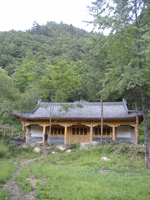Daoist monks and nuns to manage sacred mountains
 |
.jpg) |
 |
The sacred mountain Hua Shan |
The landscape of China is one of vast cities, small villages, great rivers, and long stretches of sacred mountains towering above them all. From the majesty of Hua Shan and Tai Shan to the more humble but equally sacred peaks of Qingqing and Taibaishan, the power of ancient sacred mountains continues to infuse the Chinese environment even today.
In July 2006, ARC – in association with EMF, the Ecological Management Foundation – assisted in the soft-launch of a significant new development on Taibaishan: a new ecological Daoist temple, built in partnership with the China Daoist Association and Shaanxi Province.
This was followed up in June 2007 by a second workshop, titled "Taking care of Nature: building up the Daoist Ecology Temple by our own hands", attended by 18 monks and nuns from both Shaanxi and further afield. Many more monks and nuns applied to join, and are hoping to join future workshops. It explored how they can build on the ideas about ecology promoted at the first workshop, as well as at a major conference about the Daodejing, held in Xian and Hong Kong in April 2007.
Link here for ARC's speech at the conference.
 |
 |
 |
The new Daoist ecology centre on Taibaishan |
Link here for photographs from the opening of the Daoist Ecology Temple, including a picture of the sacred tree at the base of the Tai Bai mountain, and another showing the ritual welcoming of the gods by the monks of Louguantai temple.
Link here for a presentation in Chinese from Master Dao of Louguantai temple, about how he has started to walk the path of ecology.
The mountain of Taibaishan covers a huge expanse in the centre of Qinling mountain range, south of the ancient city of Xian, where the old Silk Routes began. Venerated by both Daoists and Buddhists, this mountain is now in a protected area. At the base of Taibaishan, WWF China has created an eco-tourism centre using traditional building materials and architecture. Next door to this site stands a sacred tree, as well as the remains of an ancient Daoist temple that was destroyed in China’s Cultural Revolution of 1966-1974. The pilgrim path to the summit passes by both the tree and the temple.
ARC’s project with the Daoists has involved:
* rebuilding the temple as a model of eco-architecture using traditional sustainable materials
* building an exhibition centre
* creating a practical ecology training centre for Daoists and setting up a series of workshops on the environment, the first of which was in July 2006. The next one will take place in mid 2007.
Particularly during the non-tourist period between late September and late April, WWF will make the eco-tourism facilities at their Panda centre available for Daoist monks and nuns while ARC – in association with the Daoist academy at Longuantai monastery - will design and create further training programmes on everything from land management to Traditional Chinese Medicine to sustainable tourism.
Background to the Project
One of the first research projects ARC undertook in the mid 1990s was on the role of Daoism as a protector of the ecology of its traditional sacred mountains. Working with the China Daoist Association we surveyed all five of the main sacred mountains and developed management programmes for two of them - Hua Shan and Tai Shan. We were able to show that when Daoists were in residence on a sacred mountain, the ecology was better protected than where there were no monks.
Over the past ten years ARC has thus been able to protect them from inappropriate developments as well as create management plans in which the Daoists are both active partners and participants. This latest programme is a chance to build on these earlier successes. The project is assisted by EMF, the Ecological Management Foundation, which is one of ARC’s sponsoring bodies.
LINKS - to presentations about Daoism and the Environment
Link here for ARC's powerful presentation to the International Daoist Forum in Xian, April 22, 2007. And here for the speech in Chinese.
Presentation by Professor Fan Guiching: 西北道教生态保护实例展示
First Presentation by Dr He Xiaoxing: 环境保护的意念和项目
Second Presentation by Dr He Xiaoxing: 古老智慧和新角色:道教和环境保护
|

